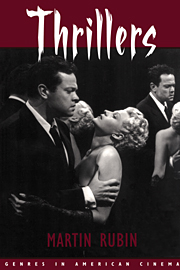Book contents
- Frontmatter
- Contents
- List of Illustrations
- Acknowledgments
- PART I APPROACHES
- PART II HISTORICAL OVERVIEW
- PART III FILM ANALYSES
- 6 The Detective Thriller: The Kennel Murder Case (1933), The Big Sleep (1946)
- 7 The Psychological Crime Thriller: Strangers on a Train (1951)
- 8 The Spy Thriller: Man Hunt (1941)
- 9 The Police Thriller: The French Connection (1971)
- 10 Conclusion
- Notes
- Selected Bibliography
- Filmography/Videography
- Index
- Frontmatter
- Contents
- List of Illustrations
- Acknowledgments
- PART I APPROACHES
- PART II HISTORICAL OVERVIEW
- PART III FILM ANALYSES
- 6 The Detective Thriller: The Kennel Murder Case (1933), The Big Sleep (1946)
- 7 The Psychological Crime Thriller: Strangers on a Train (1951)
- 8 The Spy Thriller: Man Hunt (1941)
- 9 The Police Thriller: The French Connection (1971)
- 10 Conclusion
- Notes
- Selected Bibliography
- Filmography/Videography
- Index
Summary
Having wound our way through the far-flung and mysterious maze of the movie thriller, it might be useful to get our bearings with some general observations. It might also be worthwhile to take note of a few unexplored passageways before we head for the exit and emerge into the light of day.
As noted from the start of this book, the thriller is a familiar but imprecise concept: a genre that isn't a genre, or, at least, a genre that cannot be subjected to the same definitional precision as other, more delimited genres. The thriller is a vast, ill-defined region whose horizons are the marvelous realms of romance and adventure in one direction (traditionally, the East) and the mundane, low-mimetic domains of comedy and melodrama in the other direction.
In the preceding chapters, I have tried to steer a middle course between two approaches that have characterized the few previous attempts to deal generally with the thriller. On the one hand, there are those writers (such as Brian Davis, Lawrence Hammond, and John Mc-Carty) who pragmatically accept the imprecise nature of the thriller and the subjective criteria underlying common applications of the label, but who offer few tangible guidelines outside of the vague and seemingly arbitrary preferences of the author. On the other hand, there are those (such as Jerry Palmer and Charles Derry) who boldly define the subject in a way that indeed illuminates some of its outstanding examples and central concerns but also excludes too many key works that have been widely perceived as thrillers.
- Type
- Chapter
- Information
- Thrillers , pp. 259 - 268Publisher: Cambridge University PressPrint publication year: 1999



